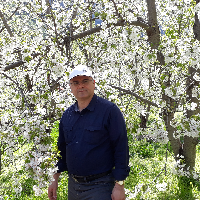Evaluation and selection of barley (Hordeum vulgare L.) doubled haploid genotypes based on root traits in seedling stage under normal and salt stress conditions
Author(s):
Abstract:
Salinity is a major abiotic stress affecting agricultural production. Barley is one of the most tolerant species among glycophyte plants to salt stress. High tolerance of barley to salinity stress is related to its rapid phonological growth and development. Understanding of growth and development of different organs of plant, especially root, is important for optimal management of halophytes (Chen et al., 2008). Root systems can exhibit enormous plasticity on the level of biomass, morphology, and or physiology in response to different environmental parameters such as water and nutrient availability. Because root system traits, such as water uptake rates per surface area, are defined by the properties of individual root segments detailed studies about the abundance, morphology, anatomy, and physiology of individual roots are needed (Rewald et al., 2012). Root length can be the most important characteristics because many researchers believe that the root length per unit volume of soil is the best feature to calculate water uptake by the plant (White and Kirkegaard, 2010). The root diameter reduces in salt stress conditions. It varies in different species (Eshel and Beeckman, 2013). Grouping of accessions by multivariate methods in would be of practical value to wheat breeders in that representative accessions may be chosen from different clusters for breeding purpose and it also helps to define strategies for further collection of germ plasm (Alavi siney et al., 2013).
The objectives of this study were to evaluate effect of NaCl salinity on seedling root traits in doubled haploid barley, grouping, ranking and selecting of superior genotypes based on studied traits.
Results and DiscussionThe results of the variance analysis showed significant differences between lines and interaction of line × salinity for all of traits. The significant differences among lines for the studied traits refer to the presence of considerable variation among lines and give a chance to plant breeders for betterment of these characters through breeding. The significant interaction between lines and Salinity shows a lines specific adaptation to different salinity. Therefore, this diversity can successfully be used for improvement of barley yield. However, the correct selection of doubled haploid lines can be considered as one of the crucial factors in farm management and economic barley production. Generally, salinity was decreased root length and cumulative root length. In four lines did not decrease the root length under salt stress and in three lines didnt show reduced cumulative root length under salt stress. The root angle, in all lines except the six lines, under Stress-free conditions was greater than the stress condition. Root area showed a downtrend in stress conditions than under normal condition those five lines are not obeyed of the law. The effect of salinity on root diameter did not show similar results among the lines. Using cluster analysis and Arunachalam and Bandyopadhyay (1984) method, barley doubled haploid lines were divided two groups based on studied traits both normal and salinity conditions. Genotypes with 2, 29 and 69 code were selected as superior genotypes in both of conditions.
ConclusionThe results of experiment showed that the root traits are affected by salt stress. Since, it is necessary, we know about the relationship between root traits such as, area and length of root and their relationship with salt stress. Salt stress decreased amount of root area, cumulative length, length of longest root and root angle. Tolerance to salinity is related to all of traits involved in salt tolerance. The root absorbs water and nutrients to the extensive role that it can play a major role in salinity tolerance. Cluster analysis based on the studied traits in both conditions (normal and stress) divided genotypes in two groups and multivariate analysis of variance confirmed these results. Arunachalam and Bandyopadhyay showed genotypes number 2, 29 and 62 were superior genotypes in both conditions. Therefore, these genotypes can be used in both of condition.
The objectives of this study were to evaluate effect of NaCl salinity on seedling root traits in doubled haploid barley, grouping, ranking and selecting of superior genotypes based on studied traits.
Materials And Methods
In order to investigate the effect of NaCl salinity on seedling root traits in doubled haploid barley, a study was carried out as a factorial experiment based on completely randomized design with three replications in the green house of Zanjan University in 2012. Fifty doubled haploid lines were studied in zero (control) and 150 mM salinity levels. Traits of the root area, root angle, cumulative root length, length of the longest root, diameter root were measured with daily imaging of the seedling. Data were analyzed by the analysis of variance (ANOVA) with using SPSS (21). Cluster analysis and Aronachalam and Bandyopadhyay(1984) were used for grouping and ranking the doubled haploid lines respectively.Results and DiscussionThe results of the variance analysis showed significant differences between lines and interaction of line × salinity for all of traits. The significant differences among lines for the studied traits refer to the presence of considerable variation among lines and give a chance to plant breeders for betterment of these characters through breeding. The significant interaction between lines and Salinity shows a lines specific adaptation to different salinity. Therefore, this diversity can successfully be used for improvement of barley yield. However, the correct selection of doubled haploid lines can be considered as one of the crucial factors in farm management and economic barley production. Generally, salinity was decreased root length and cumulative root length. In four lines did not decrease the root length under salt stress and in three lines didnt show reduced cumulative root length under salt stress. The root angle, in all lines except the six lines, under Stress-free conditions was greater than the stress condition. Root area showed a downtrend in stress conditions than under normal condition those five lines are not obeyed of the law. The effect of salinity on root diameter did not show similar results among the lines. Using cluster analysis and Arunachalam and Bandyopadhyay (1984) method, barley doubled haploid lines were divided two groups based on studied traits both normal and salinity conditions. Genotypes with 2, 29 and 69 code were selected as superior genotypes in both of conditions.
ConclusionThe results of experiment showed that the root traits are affected by salt stress. Since, it is necessary, we know about the relationship between root traits such as, area and length of root and their relationship with salt stress. Salt stress decreased amount of root area, cumulative length, length of longest root and root angle. Tolerance to salinity is related to all of traits involved in salt tolerance. The root absorbs water and nutrients to the extensive role that it can play a major role in salinity tolerance. Cluster analysis based on the studied traits in both conditions (normal and stress) divided genotypes in two groups and multivariate analysis of variance confirmed these results. Arunachalam and Bandyopadhyay showed genotypes number 2, 29 and 62 were superior genotypes in both conditions. Therefore, these genotypes can be used in both of condition.
Keywords:
Language:
Persian
Published:
Journal of environmental stresses in crop sciences, Volume:9 Issue: 4, 2017
Pages:
395 to 405
magiran.com/p1649363
دانلود و مطالعه متن این مقاله با یکی از روشهای زیر امکان پذیر است:
اشتراک شخصی
با عضویت و پرداخت آنلاین حق اشتراک یکساله به مبلغ 1,390,000ريال میتوانید 70 عنوان مطلب دانلود کنید!
اشتراک سازمانی
به کتابخانه دانشگاه یا محل کار خود پیشنهاد کنید تا اشتراک سازمانی این پایگاه را برای دسترسی نامحدود همه کاربران به متن مطالب تهیه نمایند!
توجه!
- حق عضویت دریافتی صرف حمایت از نشریات عضو و نگهداری، تکمیل و توسعه مگیران میشود.
- پرداخت حق اشتراک و دانلود مقالات اجازه بازنشر آن در سایر رسانههای چاپی و دیجیتال را به کاربر نمیدهد.
In order to view content subscription is required
Personal subscription
Subscribe magiran.com for 70 € euros via PayPal and download 70 articles during a year.
Organization subscription
Please contact us to subscribe your university or library for unlimited access!




